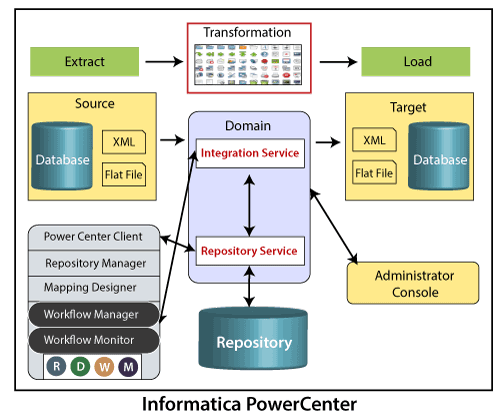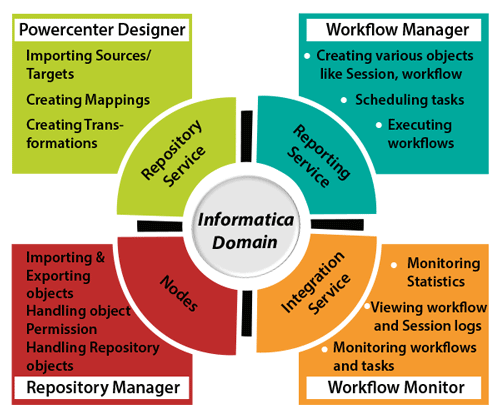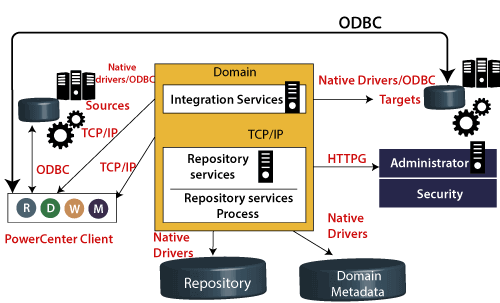Informatica ArchitectureInformatica architecture is service-oriented architecture (SOA). A service-oriented architecture is defined as a group of services that communicate with each other. It means a simple data transfer during this communication, or it can be two or more services that coordinate the same activity. The Informatica development depends upon the component-based development techniques. This technique uses the predefined components and functional units with their functionalities to get the result. PowerCenter is based on the component-based development methodologies. To build a dataflow from the source to target, it used different components, and this process is called transformation. Informatica ETL tool has the below services and components, such as: 

Informatica Domain
NodeNode is a sensible study of a machine in a domain, and a domain has different hubs. To run the application administrations, we can design the hubs, such as mix administration. PowerCenter RepositoryThe PowerCenter repository is a relational database such as SQL Server, Oracle, and Sybase. And these databases are maintained by the repository services. The database tables store the metadata. Informatica client tools are the three types, such as:
Informatica provides repository services, and it is used to manage the repository. The repository services exclusively handle one request for one repository. But we can execute it on multiple nodes for better performance. We can maintain the different versions of the same objects because of its version control mechanism. And also ignore multiple users that modifying the same object at the same time. The objects created in the repository are having this three-state, such as:
PowerCenter Repository ServicePowerCenter repository service is a different multi-strung process. It allows the customer to change the metadata in the store. It accepts demands from the considerate benefit for metadata to run work processes. Domain configurationIn the Informatica ETL tool, the domain is the necessary fundamental administrative control. It is an apparent entity that provides other different services such as repository service, integration service, and various nodes. The Informatica admin console is used for the domain configuration. And the console is launched with the help of the web browsers. PowerCenter Client and Server ConnectivityPowerCenter client tools are installed on the client-side machines. These tools are the development tools such as workflow manager, PowerCenter designer, repository manager, and workflow monitor. Informatica repository contains all the created mapping and objects in these client tools, which resides on the Informatica server. That's why client tools must have network connectivity with the server. Also, PowerCenter client connects to the sources and targets to import the metadata and structure definitions. Thus, it also maintains the connectivity to the source or target systems.
Repository ServiceThe repository service is a multithreading process. It maintains the connection between the PowerCenter clients and the PowerCenter repository. The repository service can fetch, insert, and update the metadata inside the repository. And it also maintains the consistency inside the repository metadata. Integration ServiceThe integration service is used as an execution engine in the Informatica. It helps in executing the tasks which are created in the Informatica. Integration service works in the following manner, such as:
Next TopicInformatica PowerCenter
|
 For Videos Join Our Youtube Channel: Join Now
For Videos Join Our Youtube Channel: Join Now
Feedback
- Send your Feedback to [email protected]
Help Others, Please Share









